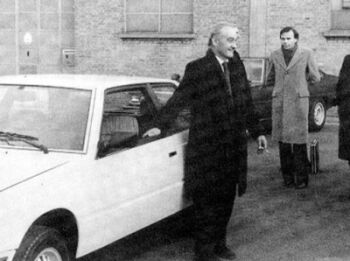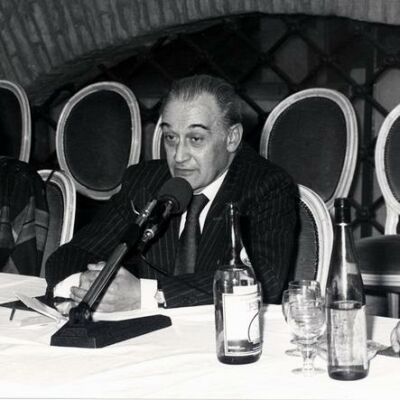 Alejandro
de Tomaso was born in Buenos Aires on 10 July 1928 to a land-owning family
of Italian origin. The Peron régime forced him to leave his native
Argentina; young Alejandro escaped to Italy with the desire to become a
racing driver.
Alejandro
de Tomaso was born in Buenos Aires on 10 July 1928 to a land-owning family
of Italian origin. The Peron régime forced him to leave his native
Argentina; young Alejandro escaped to Italy with the desire to become a
racing driver.
He succeeded, returning to Argentina in 1956 to race a Maserati 150S with Carlos Tomasi in the 1000 km of Buenos Aires.
They won their class and finished 5th overall. In 7th place was the Maserati of Carlos Lostalo and Isabelle Haskell, a blonde American from Red Bank, New Jersey.
In January 1957, Haskell and de Tomaso shared a 1.5-litre OSCA built by the Maserati brothers in the Buenos Aires race; they finished 6th overall and got married in West Palm Beach, Florida in March the same year. Their partnership continued on the track coming first in class, first in Index of Performance and 8th overall in the 1958 Sebring 12 Hours with a 750cc OSCA.
De Tomaso’s racing career continued with an 11th place overall at the 1958 Le Mans 24 Hours, driving with Englishman Colin Davis, and finally ended with an 18th overall finish in partnership with Ricardo Rodriguez at the Sebring 12 Hours in 1960.
The de Tomaso family started building their own racing cars from October 1959. Adding mid-engined road cars from 1963, they establishing close links with coachbuilder Ghia and the Ford Motor Company.
Around 1967/68 Alejandro de Tomaso, with backing from Henry Ford II, negotiated with the Orsi family to sell their shares in Maserati to the Ford Motor Company. However, Adolfo and Omer Orsi, along with technical director Giulio Alfieri, opted for a merger with Citroën instead. Ford in turn bought De Tomaso Automobili, the Ghia studio and coachbuilder Vignale.
Alejandro de Tomaso finally
got hold of Maserati in 1975 after Citroën's new master Peugeot closed
down the Modena factory. The mayor of Modena asked de Tomaso to talk to
Gianni Agnelli to save Maserati, but Fiat – which also owned Lancia and
Ferrari - was also navigating in troubled waters around the same time.
With financial backing from the government agency, GEPI, de Tomaso took
control of Officine Alfieri Maserati from November 1975. He integrated
production with Innocenti, a small Milan-based car manufacturer, and motor
bike makers Moto Guzzi and Benelli.
His second-in-charge, Aurelio
Bertocchi, was the son of legendary Maserati chief mechanic and test driver
Guerrino Bertocchi.
The first Maserati conceived under de Tomaso’s management - the Kyalami, a restyled and re-engineered De Tomaso Longchamp - was launched at the Geneva motor show in March 1976, just five months after the takeover. The Italdesign-styled Maserati Quattroporte luxury saloon re-established Maserati in the market around 1980, selling in larger numbers (2,141) than any of Maserati's previous GT cars.
Maserati returned to the
2-litre class, where its road car production had started 35 years earlier,
from December 1981 with the Biturbo. The move was dictated by late ‘70s
Italian market conditions, as well as by the Italian government which was
a major shareholder of both Maserati and Innocenti through the GEPI agency,
then headed by Romano Prodi. Highly controversial in its day, the Biturbo
range introduced traditional Italian GT car values and performance to a
far larger clientele, topping with annual production figures in the region
of 5,398 to 6,356 cars between 1983 and '85.
Alejandro de Tomaso passed
away the night of 20th May. He had been wheelchair-bound since a stroke
in February 1993.
